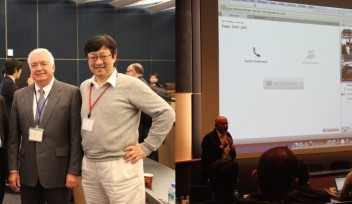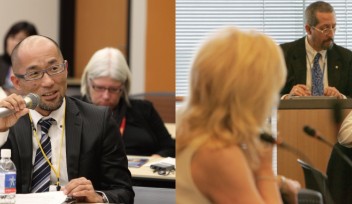Energy Starts at Home

The future of sustainable energy is likely to include widespread production and distribution, or what some are now calling “open energy systems.”
Instead of power produced and distributed solely by large utilities, open energy systems enable smaller providers — a single home, neighborhood or town — to produce power that they then use, often from renewable sources like wind and solar. Agile micro-grids, in which consumers become producers, make it possible to turn lights on in remote villages. But open energy systems also have the potential to help developed nations move away from fossil fuels by producing and distributing renewable energy on more localized and reliable scales.
This more open system is not too far off from becoming a reality, according to Hiroaki Kitano, a professor at Okinawa Institute of Science and Technology Graduate University (OIST) in Japan.
“We are moving into a new era,” Kitano said during the Second International Symposium on Open Energy Systems held at OIST Feb. 2 and 3. “We will continue with our research, but we can start talking about real deployment.”
More than 100 energy experts, venture capitalists and government officials from all over the world gathered at OIST to share their experiences with renewable energy and discuss the potential of creating a more open, distributed energy system.
As an example of an open energy system, Kitano showed participants the direct current micro-grid system installed on OIST faculty housing. Kitano and colleagues from the Sony Computer Science Laboratories, Inc. (Sony CSL) designed the system that combines solar panels with a so-called “energy server.” Okinawa, with its’ sub-tropical environment, salty air and typhoons, provides a suitable proving ground for other island nations that might use this sort of system.
“OIST is the best place on Japanese soil to do this kind of research,” said Kitano, who is also the president of Sony CSL. “If we can operate properly in Okinawa we can operate in other places.”
Solar panels on 19 buildings generate energy and each home has an energy server. The servers talk directly to each other, and the peer-to-peer system redistributes the energy as necessary between the homes automatically. Sony’s Phospho-olivines Lithium Ion batteries store electricity that can be used when the sun goes down. Managers monitor energy production and usage in real time, to see how it is being transferred throughout the micro-grid. The system has been providing reliable, consistent power since December 2014.
“I’ve been in solar energy since the 1990s and this is the first direct current system I’ve seen,” said Jon Dogterom, venture services lead for MaRS, a venture capital firm based in Toronto, Canada. “It’s very impressive.”
With growing populations, climate change, and shifting energy sources, the need to boost renewable energy sources and use energy more efficiently has never been greater. There are many emerging technologies and platforms striving to make that possible, from solar and hydrogen, to smart thermostats and energy use apps that kill off a cute cartoon teddy bear if you use too much power.
“It’s the best time since Edison for energy,” said Ariel Liebman, an information technology professor and energy market expert from Monash University in Australia, referring to Thomas Edison, who pioneered commercial electric power distribution.
Liebman noted he had not heard of the term “open energy system” before being invited to speak at the symposium. “I am excited there is a new word talking about these things because ‘smart grid,’ the term is starting to outlive its usefulness,” he said.
Participants largely agreed that consumers will become more and more engaged with production and management of energy through a variety of technologies. But the timing has to be just right for the concept to really take off.
“The stars are very close to being in the right place for a lot of these offerings,” said Philip Lewis, CEO and Founder of VaasaETT, a global energy think tank based in Finland.
When thinking about how to redesign energy systems, it is important to stay flexible because of so many unknowns, said Patrick Whitney, a professor of design at the Illinois Institute of Technology in the United States. “Designing for what we don't know yet is really important,” he said. “The way to do that is to create platforms, rather than solutions.”
By Laura Petersen
For media inquires, please contact media@oist.jp.
Specialty
Research Unit
For press enquiries:
Press Inquiry Form



















